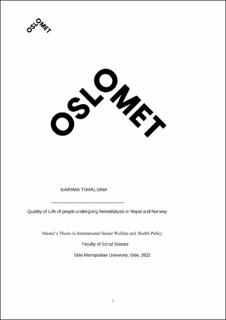| dc.description.abstract | Introduction
Chronic kidney disease is increasing day by day in the world and it has become one of the leading reasons for mortality over the world. Currently, in the world, it is estimated that nearly 13.4% of people are suffering from chronic kidney disease. and the patient having ESRD and needs renal replacement therapy is estimated between 4.902 and 7.083 million. For survival from kidney disease, patients must undergo Renal Replacement Therapy (RRT), which includes Hemodialysis, Peritoneal Dialysis, and Renal Transplantation. Quality of life has become a worthwhile research tool in evaluating the results of treatment interventions in chronic diseases.
Methods
The purpose of this thesis is to explore the quality of life of people with chronic kidney disease in Nepal and Norway. The primary research question is ‘What is the quality of life of people with CKD/ESRD?’ and the secondary research question is ‘What is the impact of hemodialysis on the Quality of life of people with CKD/ESRD?’ The literature review method is used to do this assignment. To answer my first research question, I identified all studies that measured the QOL of patients at one point in time, using any questionnaire. To answer research question two, I first tried to find randomized controlled trials that compared hemodialysis with a control group, to estimate the impact of hemodialysis on the quality of life of people with CKD\ESRD. When this was not possible, I tried to find other study designs. I searched electronic databases to identify relevant studies.
Findings
All together six studies met inclusion criteria and were analyzed; three studies were from Nepal and three from Norway. The answer to the quality of life of chronic kidney disease is undetermined. And for the second research question there did not appear to be any improvement in the quality of life for patients undergoing hemodialysis longer.
Conclusion
The study demonstrated that there are no differences in the quality of life of patients having chronic kidney disease in Nepalese\Norwegian patients and length of hemodialysis does not have any relationship with quality of life in both the countries. There can be various associated factors that have an impact on quality of life, that were not measured. Women, people with higher education, married people, or cohabiting reported a higher quality of life but people who are unemployed, geriatric patients, and have any disease or health problems have a lower quality of life. | en_US |
